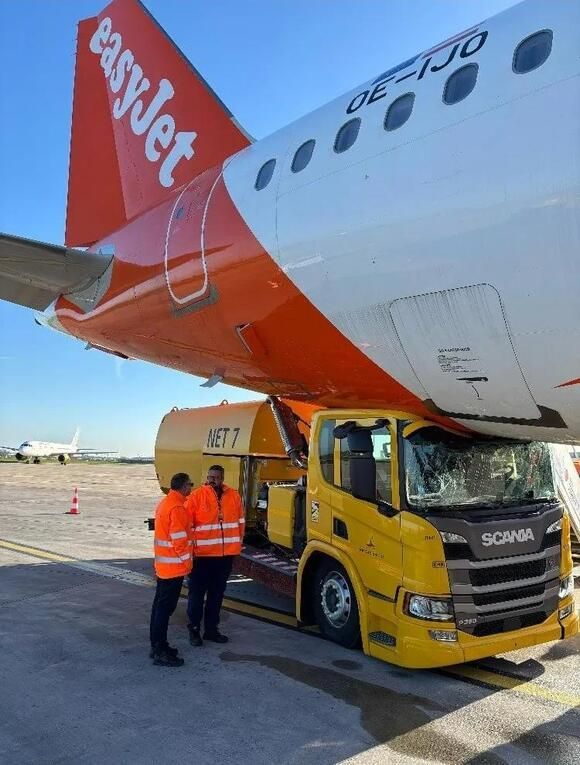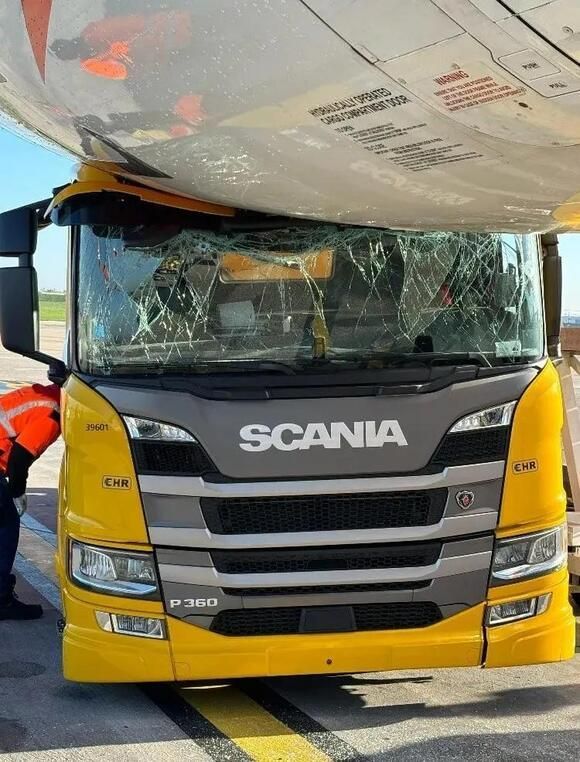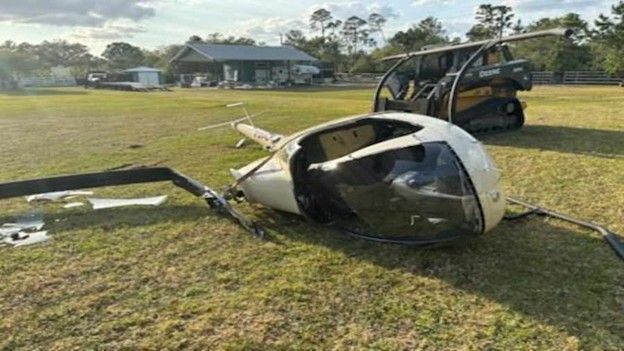ARFF Daily News
Published on:
Monday the 31st of March, 2025
Lorry smashes into easyJet plane on airport tarmac sparking travel chaos as shocking pics show wrecked fuselage
By Stephen Moyes
EASYJET passengers’ travel plans went belly-up today when a lorry accelerated into the undercarriage of a jet.
Chaos ensued as the plane was set to transport Brits around Europe on six flights.
Dramatic pictures obtained by The Sun showed how significant damage was done to the aircraft’s fuselage.
Emergency vehicles attended the scene, and easyJet bosses launched an immediate enquiry.
A yellow Scania vehicle careered into the rear of the 15-year-old twin-engine Airbus A320 with 146 seats.
The heavy duty truck’s windscreen could be seen smashed amid the drama at Paris Orly airport early Monday morning.
A source told The Sun: “It happened first thing and everyone is in shock. It’s baffling how this happened.
“There was no way the plane could take off. It was due to complete six flights today but will now be grounded for rigorous safety checks.
“Bosses were forced to rip up flight plans. It’s a major incident and will leave a bill in excess of £100,000.”
The Sun understands that investigators are probing if the ground services truck driver accidentally pressed the accelerator rather than the brake – causing his vehicle to career into the jet.
A similar incident caused delays before the take-off of a British Airways aircraft in Marrakesh in 2023.
An airline spokesperson told The Sun: “EasyJet can confirm that an airport vehicle struck an aircraft at Paris Orly airport while it was parked overnight and no passengers were on-board.
“The aircraft will undergo the required inspections and repairs in line with manufacturer instructions.”
It comes after an EasyJet pilot was suspended after his packed holiday jet flew too close to a mountain and was just seconds away from disaster.
Captain Paul Elsworth was grounded following the cockpit drama as the plane descended towards the Red Sea resort of Hurghada in Egypt.
Meanwhile, a holiday jet row over a boy watching The Karate Kid saw a passenger bust-up at 30,000ft and emergency diversion.
The easyJet pilot decided to land after two families came to blows.
Both of them were thrown off the plane when it landed to be greeted by police.
But the five-year-old boy’s mum insists they were the victims and is threatening to sue the airline, which has banned those involved from future flights.
She said: “This incident involved racial abuse, discrimination, and physical assault.
“My son was left extremely scared and distressed.”
https://www.newsbreak.com/the-us-sun-513995/3942826877196-lorry-smashes-into-easyjet-plane-on-airport-tarmac-sparking-travel-chaos-as-shocking-pics-show-wrecked-fuselage



Pilot sole fatality and no injuries in Brooklyn Park plane crash Saturday
US Bank said it believes pilot was Terry Dolan, vice chair and chief administration officer at the bank
By Kristi Miller
The pilot was the sole fatality and there were no other injuries after a plane crashed through the roof of a Brooklyn Park house on Saturday, officials said in a news conference.
One person inside the home was able to escape without injuries. A second resident was not home at the time, Brooklyn Park Fire Chief Shawn Conway said Sunday.
The pilot was the sole occupant in the plane. The pilot’s identity will be released by the Hennepin County Medical Examiner’s office, said Dr. Jessica Campbell, a forensic anthropologist at the office.
However, a spokesperson with U.S. Bank said the pilot may be 63-year-old Terry Dolan, vice chair and chief administrative officer at U.S. Bank.
“We are aware that the plane that crashed in Brooklyn Park on Saturday afternoon was registered to Terry Dolan, our vice chair and chief administration officer. At this time, the medical examiner’s office has not been able to confirm whether he was on board, but we believe he was. Our thoughts and prayers are with him, his family and friends, and anyone who may have been affected by yesterday’s tragic incident,” said Jeff Shelman, spokesman for U.S. Bank. “We are grateful that there were not any injuries to residents of the home that was impacted by the crash, and we thank all the first responders who have provided service.”
U.S. Bank has its headquarters in downtown Minneapolis.
The crash occurred about 12:20 p.m. Saturday near the intersection of 109th Avenue North and Noble Parkway. A house was completely destroyed by the plane landing on the roof and plummeting into the basement, starting a fire that consumed the house, Conway said.
A neighboring home suffered damage to its siding and some homes have debris from the crash in their yards, he said.
All utilities have been restored to the remaining homes in the neighborhood, Conway said, noting that crews will still be working in and around the neighborhood for some time.
The investigation into the crash has been formally turned over to the National Transportation Safety Board, he said.
The NTSB’s focus on Sunday was to document the accident site before removing the airplane, said Tim Sorensen, aviation accident investigator with the NTSB.
The damage to the aircraft was great. “Suffice it to say it’s severe, it’s significant,” Sorensen said. “We will recover the aircraft this afternoon and it will be taken to a location where a more detailed investigation can be done.”
The investigation is just getting started, he said, so “we don’t have a lot of answers right now,” citing the fire sparked by the crash as increasing the investigation’s challenges.
As part of its investigation, the NTSB will look at the weather, the pilot’s experience, and the maintenance and status of the aircraft. A preliminary report on the accident will be released in 10 days to two weeks, which won’t include the crash’s cause, but will include information they can verify by then, Sorensen said.
Sorensen said the NTSB has not confirmed the origin of the plane or its final destination.
However, the Federal Aviation Administration said Saturday that a SOCATA TBM7, a single-engine turbo-prop plane, crashed after leaving Des Moines International Airport in Iowa and was headed to Anoka County-Blaine Airport.
“There’s plenty of those types of aircraft out there and they fly safely every day, every accident is unique,” Sorensen said. “We look at the unique circumstances and document every accident. That is the process we are involved in right now.”
https://www.twincities.com/2025/03/30/pilot-sole-fatality-and-no-injuries-in-brooklyn-park-plane-crash-saturday/


Helicopter crashes in backyard of Seminole County home, fire officials say
Crash reported near 1236 Galant Fox Way
Anthony Talcott, Digital Journalist
SEMINOLE COUNTY, Fla. – A helicopter crashed in the backyard of a Chuluota home on Friday, according to the Seminole County Fire Department.
In a release, fire officials said they received a report about the crash shortly before 6 p.m. at 1236 Galant Fox Way.
“It is confirmed that this was a small helicopter that crashed on its side in an unplanned landing,” the release reads.
According to fire officials, no buildings were struck by the aircraft, and the pilot denied having injuries when first responders arrived.
News 6 spoke with the pilot’s wife, who said he had gotten his pilot license and received the helicopter a few days ago.
He had tried to turn it around, but when he fired it up, the wind blew it over with him still inside, she explained. The aircraft didn’t even leave the ground.
The FAA is set to investigate the crash. No additional information has been provided.

Deadly plane crash in NJ neighborhood sounds like bomb explosion
Dan Alexander
FRANKLIN (Somerset) — A small plane crashed into a Somerset County neighborhood Sunday afternoon.
According to the FAA, a single-engine Cirrus SR22 took off from Princeton Airport around 10:35 a.m. headed for Raleigh-Durham International Airport in North Carolina.
Township police were notified an hour later that contact was lost with the plane somewhere over the township.
State Police launched an air search while Millstone Valley Fire Department deployed a drone.
Franklin police say the plane was located in a brushy area near South Middlebush Lane and Hilltop Lane. Ground crews confirmed one person was inside the plane.
The immediate area was evacuated as a safety precaution for a time.
'Sounded like a bomb that had gone off'
Former mayor Chris Kelly, who lives in the neighborhood near the cars,h told the Franklin Reporter he heard the engine of the plane “straining” to gain altitude followed by what sounded like a bomb.
"It was very, very frightening and it sounded like it was very close," Kelly told the Reporter.
The identity of the pilot has not been disclosed. The NTSB and FAA will investigate the crash.
Nearly 12 years to the day, two people were injured in a small plane crash on Weston Canal Road in Franklin Township, according to NJ.com coverage.
The FAA said a two-seat Piper PA-38 Tomahawk hit three utility poles during a forced landing during the April 2, 2011 crash.

United Airlines plane strikes kite while landing at Reagan National Airport in ‘scary’ incident— just months after fatal mid-air crash
By Isabel Keane
A United Airlines flight hit a kite while landing at Washington’s Reagan National Airport on Saturday afternoon — months after a deadly collision at the same airport killed 67 people.
The pilot aboard United Flight 654 from Houston to DCA can be heard over air traffic radio providing details about the kite — which was spotted from the cockpit, WUSA 9 reported.
It’s the latest scary mid-air incident in one of the most crowded flight paths in the country. This time, the threat came from Gravelly Point Park, a popular spot just north of the airport on the Potomac River.
“You were telling me those details about the kite, whether it was over the park? How high was it?,” an air traffic controller says in audio from LiveATC.net.
The United pilot replies: “It was over the park about 100 feet over the ground, it looked like it was right on the flight deck. Those guys were a little bit low …”
Dylan Oakes, a WUSA9 producer and former flight attendant, was at Gravelly Point in Arlington with his partner at around 4 p.m. on Saturday and watched the United flight snag the kite.
“There was a kite that looked a little higher than it should be, we thought it might just be a perspective thing from where we were standing but, lo and behold, as the plane got a little bit closer, it came into contact with the kite,” Oakes told the outlet.
The incident follows a near-miss on Friday when a Delta Air Lines plane that was taking off from the airport came within a few hundred feet of US Air Force Northrop T38 Talon trainer jets that were arriving for a fly-over at Arlington National Cemetery.
In January, an American Airlines flight from Wichita collided with an Army Blackhawk helicopter that was flying too high, killing all aboard both aircraft. It was the deadliest US air disaster since 2001.
There were no injuries from Saturday’s close-call with the kite.
“The kite fell to the ground. The plane landed safely, thankfully everyone’s OK, but it’s just a little scary given the recent history at DCA — our issues with close calls and what happened two months ago,” Oakes said.
The situation could have become dire if the kite had been sucked into the plane’s engine, Oakes added.
“It could be serious … planes shouldn’t be coming into contact with anything. This kite could have been ingested into an engine, the engine could have possibly failed,” Oakes added. “You’re in a critical phase of flight on the approach.”
Oakes said he also saw Washington Metropolitan Airports Authority officers later confiscate the kite from a family in Gravelly Point. It was returned soon after.
“Airports Authority police officers responded to reports of kite-flying at Gravelly Point today, an activity which is not allowed in that area due to the danger of to low-flying aircraft,” a MWAA spokesperson told WUSA9.
“Officers warned some individuals about flying kites and briefly confiscated a kite. That kite was returned to its owner shortly later and no charges were filed.”
In a statement, United Airlines said there was no damage to the plane and no injuries were reported in the incident.
“We are aware of reports that a kite struck UA flight 654 from Houston to Reagan Airport in Washington, D.C.,” the airline said. “The aircraft landed safely, customers deplaned normally and upon inspection there was no damage to the aircraft.”
https://nypost.com/2025/03/30/us-news/united-airlines-flight-hits-kite-at-reagan-national-airport/

NTSB Prelim: Aeronca 7CCM
Airplane Collided With Trees Which Resulted In Substantial Damage To The Left Wing
Location: Kenai, AK Accident Number: ANC25LA026
Date & Time: March 20, 2025, 14:00 Local Registration: N2527B
Aircraft: Aeronca 7CCM Injuries: 1 None
Flight Conducted Under: Part 91: General aviation - Personal
On March 20, 2025, about 1400 Alaska daylight time, a Aeronca 7CCM, N2527B, was substantially damaged when it was involved in an accident near Kenai, Alaska. The pilot was not injured.
The airplane was operated as a Title 14 Code of Federal Regulations Part 91 personal flight.
The pilot reported that during cruise flight at about 1,500 ft mean sea level the engine loss total power. The pilot initiated a forced landing to an old, abandoned access road. During the landing, the airplane collided with trees which resulted in substantial damage to the left wing.
The airplane was recovered to a secure location for further examination.
FMI: www.ntsb.gov
NTSB Prelim: Piper PA-28-140
Tachometer Was Reading About 2,350 Rpm During The Takeoff Roll From Runway 14
Location: Pearland, TX Accident Number: CEN25LA111
Date & Time: March 6, 2025, 11:45 Local Registration: N54479
Aircraft: Piper PA-28-140 Injuries: 1 Minor, 1 None
Flight Conducted Under: Part 91: General aviation - Personal
On March 6, 2025, about 1145 central standard time, a Piper PA-28-140 airplane, N54479, was substantially damaged when it was involved in an accident near Pearland, Texas. One pilot sustained minor injuries, and the other pilot was not injured. The airplane was operated as a Title 14 Code of Federal Regulations Part 91 personal flight.
The pilot reported that he departed the Pearland Regional Airport (LVJ), Pearland, Texas, and was destined for La Porte Municipal Airport (T41), La Porte, Texas. The left-seat pilot assumed the duties of pilot flying (PF) for the take-off from LVJ. The pilot monitoring (PM), seated in the right seat, stated that he noticed the tachometer was reading about 2,350 rpm during the takeoff roll from runway 14, which he noted was lower than normal. The PM directed the PF to increase the airplane’s airspeed before rotation. The PM stated that the airplane rotated about 65-67 mph, the engine instruments were “green,” and the engine sounded normal.
About 200 ft above ground level, both pilots noticed that the engine rpm had decreased to about 2,200. The PM told the PF to pitch for 85 mph for the airplane’s “best climb.” The vertical speed indicator indicated a 100 foot-per-minute climb but then settled to level flight. The PM took over the PF duties. He pitched the airplane to achieve “best glide” and planned to conduct a forced landing to a field about 1 mile from the departure end of runway 14. The engine continued operating with partial power during the forced landing. The airplane impacted a wood pile and came to rest along a dirt embankment. A post-impact fire ensued and both pilots were able to egress using the main door. The airplane sustained substantial damage.
Before the flight, the airplane was filled with 47 gallons of 87-octane ethanol-free automotive fuel. The airplane was recovered for further examination.
FMI: www.ntsb.gov
NTSB Final Report: Tecnam P2010
Loss Of Engine Power Was Not Preceded By Any Abnormal Signs Or Engine Indications
Location: Ocala, Florida Accident Number: ERA24LA011
Date & Time: October 17, 2023, 10:50 Local Registration: N118T
Aircraft: Tecnam P2010 Aircraft Damage: Substantial
Defining Event: Unknown or undetermined Injuries: 2 Serious
Flight Conducted Under: Part 91: General aviation - Instructional
Analysis: The pilots reported the engine suddenly lost power during the initial takeoff climb at an altitude of 300 to 400 ft above ground level (agl) during the instructional flight. The loss of engine power was not preceded by any abnormal signs or engine indications. The instructor took over control of the airplane and attempted a forced landing in the grass near the runway. During the forced landing, the left wing dropped, and the airplane impacted the grass in a left-wing-low, nose-down position.
Postaccident examination of the airframe and engine did not reveal any mechanical irregularities or failures that would have precluded normal engine operation. Corrosion that was discovered on both magnetos was attributed to the airplane being stored outside in a hot humid environment after the accident in the months leading up to the full examination. No other mechanical irregularities were discovered, and a maintenance logbook review did not reveal recent maintenance that may have been related to the sudden loss of engine power. Based on witness statements and signatures of the wreckage, the instructor likely did not maintain adequate airspeed during the forced landing attempt, which resulted in an aerodynamic stall and extremely hard landing.
Probable Cause and Findings: The National Transportation Safety Board determines the probable cause(s) of this accident to be -- A total loss of engine power for reasons that could not be determined. Contributing to the accident was the flight instructor’s failure to maintain adequate airspeed and exceedance of the airplane’s critical angle of attack during the forced landing, which resulted in a hard landing.
FMI: www.ntsb.gov

Today in History
30 Years ago today: On 31 March 1995 Tarom flight 371, an Airbus A310, crashed following a loss of control after takeoff from Bucharest-Otopeni Airport, Romania, killing all 60 occupants.
Date: Friday 31 March 1995
Time: 09:08
Type: Airbus A310-324
Owner/operator: Tarom
Registration: YR-LCC
MSN: 450
Year of manufacture: 1987
Total airframe hrs: 31092 hours
Cycles: 6216 flights
Engine model: P&W PW4152
Fatalities: Fatalities: 60 / Occupants: 60
Other fatalities: 0
Aircraft damage: Destroyed, written off
Category: Accident
Location: 3 km N of Bucharest-Otopeni International Airport (OTP) - Romania
Phase: En route
Nature: Passenger - Scheduled
Departure airport: Bucharest-Otopeni International Airport (OTP/LROP)
Destination airport: Brussel-Zaventem Airport (BRU/EBBR)
Investigating agency: Romania MoT
Confidence Rating: Accident investigation report completed and information captured
Narrative:
Tarom flight 371, an Airbus A310, crashed following a loss of control after takeoff from Bucharest-Otopeni Airport, Romania, killing all 60 occupants.
Flight RO371 was a scheduled passenger service from Bucharest Otopeni Airport (OTP) in Romania to Brussel Airport (BRU), Belgium. On board were 49 passengers and eleven crew members. The first officer was pilot flying, the captain was pilot monitoring.
Following de-icing, the Airbus A310 taxied to runway 08R for departure. The flight was cleared via the Strejnic 'STJ' VOR/DME beacon and an initial climb to flight level 260. Takeoff was initiated at 09:04 hours local time.
When airborne, the captain announced positive climb and co-pilot requested to retract the landing gear. At 09:07:20 the captain called the Otopeni Approach controller and received a clearance to turn left and proceed direct to STJ.
The co-pilot asked the captain to select direct STJ on FMS. The captain confirmed a direct STJ selection and requested the co-pilot to move the control wheel slightly.
At an altitude of 1700 feet and speed a 187 knots, with flaps 15/slats 15 and pitch angle of 17.6 degrees, the aircraft was turning left, with a bank angle of 12 degrees, flying towards STJ.
At 09:07:36, when the aircraft crossed 2000 feet at 188 knots, an engine thrust asymmetry started developing with continuous decrease of the left engine thrust, approximately 1 degree TRA (throttle resolver angle)/second.
At 09:07:53, when the aircraft was crossing 3300 feet altitude at 195 kts turning with a decreasing bank angle of 20 degrees, the first officer called "250 in sight" and asked the captain to retract the flaps. This was carried out. At that moment, the engine thrust asymmetry reached 14.5 TRA degrees and 0.19 for EPRs.
The first officer then requested slats retraction, but this action which was not carried out by the captain. At this moment the aircraft was passing through 013 degrees magnetic heading, at 3800 feet altitude and a decreasing speed of 185 kts. The aircraft pitch angle was 16,5 degrees, decreasing, and the left bank angle was 18 degrees, also decreasing. At that time the thrust asymmetry reached was 28 TRA degrees and 0.27 for EPRs.
At 09:08:02, the first officer asked the captain: "Are you all right?" The aircraft was passing through 330 degrees magnetic heading, 4200 ft altitude, a decreasing speed of 181 kts, and an increasing 17 degrees left bank angle.
At 09:08:08, a noise like an uttering of pain or a metallic noise was heard. The aircraft was crossing 4460 ft altitude, 179 kts speed and an increasing bank angle of 22 degrees. At that time the engines thrust asymmetry reached 0.36 for EPRs.
The bank angle continued to increase to 28 degrees and the engine thrust asymmetry reached 0.41 for EPRs.
At 09:08:15, the first officer, with a stressed and agitated voice, requested engagement of autopilot no. 1. The aircraft was crossing 4620-ft altitude, continuing its turn at an increasing bank angle of 43 degrees and a steadily decreasing pitch angle of 3.5 degrees.
One of the pilots attempted to engage autopilot no. 1 The aircraft started a descent with 45 degrees bank angle and the engine thrust asymmetry had reached the maximum value of 0.42 for EPRs, followed by a continuous thrust reduction of engine no. 2.
One second later, there was recorded autopilot disengagement followed by the aural warning a level 3 "cavalry charge" lasting several moments. From that moment on, the aircraft started diving, the speed increased and the aircraft performed a complete rotation around its roll axis.
At 09:08.28, first officer cried out "THAT ONE HAS FAILED!" without any other comments. The aircraft was descending through 3600 ft at 258 kts speed and an increasing nose down pitch angle at 61.5 degrees.
The aircraft continued until it impacted the ground at a nose down attitude of approximately 50 degrees pitch angle with both engines at idle power. The airplane was destroyed and all 60 occupants were sustained fatal injuries.
The investigation commission consider the following causal factors:
- Thrust assymetry;
- Possible pilot incapacitation (the Captain);
- Insuficient corrective action from the Copilot in order to cover the consequences of the first factors.
The French Ministry of Transport commented on the Romanian investigation report, stating that the pilot flying's actions that led to the loss of control could have been caused by the fact that the artificial horizon between Eastern and Western built aircraft is inverted in roll and that the first officer spent the majority of his carreer on Eastern-built aircraft.

